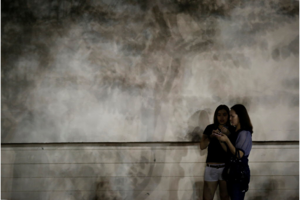Is Pokémon Go racially biased?
#mypokehood raises the question: Why are there fewer Pokémon stops in minority neighborhoods?

People play the augmented reality mobile game Pokémon Go by Nintendo in Hong Kong. In the US, some Pokémon players are wondering why there seem to be fewer Pokémon stops in minority neighborhoods.
Tyrone Siu/Reuters
Pokémon come in all colors but seem to congregate in white, urban areas.
Pokémon Go players have noticed a racial discrepancy in where it's easy to play the game. While some neighborhoods have an abundance of Pokéstops and gyms for players to pick up virtual loot and face off their monsters against competitors, others are near complete dead-zones.
Writer Aura Bogado started the hashtag #mypokehood to crowdsource data on how Pokéstops were distributed in different parts of the country after she noticed the difference between playing the game in her predominantly minority Los Angeles neighborhood and Long Beach, which is nearly 50 percent white, as USA Today reported. Players from rural and minority communities shared screenshots of how Pokémon Go looked from their backyards – sometimes with no Pokémon locations in sight.
Zooming out to look at the big picture confirms these users' experiences. As the share of the white population increases, Pokéstops and gyms become more plentiful, according to an analysis of the game by the Urban Institute in Washington DC.
"In neighborhoods that are majority white, there are 55 portals on average, compared with 19 portals in neighborhoods that are majority black,” write Shiva Kooragayala and Tanaya Srini, who controlled for relevant factors including population density and the distribution of Millennials.
Fitting the same pattern, Miami has more portals in its white and Hispanic neighborhoods than its black ones, according to the Belleville News-Democrat. Chicago's majority black South Side is largely devoid of portals, though they're easy to find in other parts of the city.
But there's no evidence that Pokémon game-makers deliberately left certain communities behind. Instead, Pokémon locations were imported from an earlier Niantic augmented reality game called Ingress. The locations of Ingress portals were crowdsourced, from both people who contributed information about landmarks to the Historical Marker Database and later from players of the games themselves.
Ingress players tend to skew male, young, and English-speaking, according to 2013 and 2014 surveys, whereas the database volunteers were mostly male and older, as the Belleville News-Democrat reported. Though more comprehensive demographic information isn't available, the overwhelmingly male and tech-savvy individuals tagged the locations now used for Pokéstops and gyms based on where they frequented, not offering a comprehensive tour of the city.
"As one Pokémon Go player put it, the sites were selected 'by people with smartphones, tech knowledge, and spare time,' which leaves out poorer segments of the population, including many minority communities, who may not have the spare time or money to spend on games like Ingress and Pokémon Go," Jeffery Vagle, executive director of the Center for Technology, Innovation and Competition at the University of Pennsylvania Law School, wrote in a blog post.
It's currently not possible to submit a new location for a Pokéstop or gym, so the diverse group of Pokémon Go players haven't gotten to propose new ideas based on their surroundings.
Aura Bogado offered a suggestion as a preliminary measure to more equally distribute Pokémon Go locations: adding Pokéstops to all bus stops.
Long-term, technology companies should be better be able to predict and account for how their games and programs will interact with society if they hire more social scientists and people of color, Safiya Umoja Noble, professor of information studies and African-American studies at UCLA, tells USA Today. “This is not a new story in terms of a product having some type of – whether intended or unintended – discriminatory effect.”

